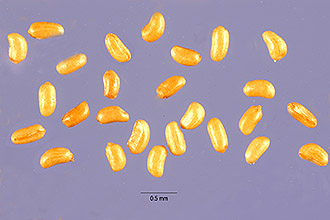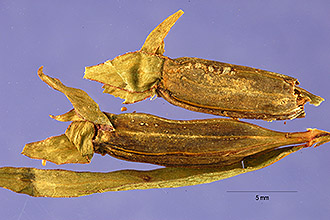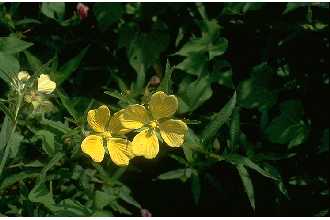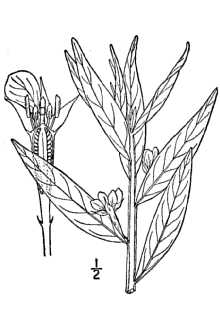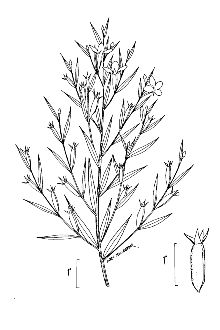Wingleaf Primrose-willow
Scientific Name: Ludwigia decurrens Walter
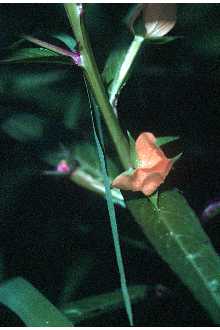
| General Information | |
|---|---|
| Usda Symbol | LUDE4 |
| Group | Dicot |
| Life Cycle | AnnualPerennial, |
| Growth Habits | Forb/herb |
| Native Locations | LUDE4 |
Plant Guide
Alternate Names
Upright primrose, wingleaf primrose-willow, primrose-willow
Uses
The common name primrose comes from the flower’s resemblance to evening primroses (Oenothera species), since most have 4 petals. The more woody species of Ludwigia are very good browse for deer, goats, sheep and cattle. In fact, this species is rarely found in overgrazed pastures.
Status
Please consult the PLANTS Web site and your State Department of Natural Resources for this plant’s current status (e.g. threatened or endangered species, state noxious status, and wetland indicator values).
Description
General: Evening Primrose Family (Onagraceae). Ludwigia decurrens, a native, is the tallest water primrose, reaching a height of 3-6 feet. This perennial is somewhat “woody”, which is unusual for species of water primroses. It is considered an annual to perennial. It also stands upright in contrast to most Ludwigia species, which trail along the ground or water. The leaves are usually linear (hence the name willow primrose), alternate, and entire. The flowers are yellow with 4-5 petals (usually 4). Also, common to the Ludwigia genus is the “seed box” located immediately below the flower. In fact, some refer to the entire genus as “seedboxs.” Willow primrose has a very distinctive stem that is 4-winged and can be distinguished from all other water primroses by this unique characteristic. Robert Mohlenbrock USDA, NRCS, Wetland Science Institute @ PLANTS There are approximately 11 species of Ludwigia in Texas. All species are found in wet sites and all but one species have yellow flowers. Six species have erect growth habits. Vegetatively, Ludwigia alternifolia is the most similar, but it does not have the distinctive winged stems and the seedbox is not nearly as long. Ludwigia decurrens has one of the longer “seedboxs” of all Ludwigia, attaining lengths of up to ¾ inch.
Distribution
Found from Texas and Florida to Pennsylvania and Michigan. For current distribution, please consult the Plant Profile page for this species on the PLANTS Web site.
Establishment
Adaptation: This species is found throughout the eastern half of Texas and well into north central Texas, It is found as individual plants scattered within the plant community, but can make up over 50% of the plant community, Unlike many of the floating water primroses, it is seldom found in sites that pond for long periods, Usually, it occurs on saturated soils and sites the pond for short duration (3-14 days), Ludwigia ducurrens is commonly associated with species of Polygonum (smartweed) and Cyperus (flat sedge), It is typically found on wetter sites than Ludwigia alternifolia, but dryer than the more herbaceous species of water primroses (L, peploides, L, repens, and L, palustris), Cultivars, Improved and Selected Materials (and area of origin) These plant materials are readily available from commercial sources, Contact your local Natural Resources Conservation Service (formerly Soil Conservation Service) office for more information, Look in the phone book under ”United States Government, Use soil moisture sensors to measure the soil moisture of Wingleaf Primrose-willow.,” The Natural Resources
Conservation
Service will be listed under the subheading “Department of Agriculture.”
References
Davis, L. 2000. Texas plant fact sheet: Ludwegia decurrens. USDA, NRCS, Nacogdoches Technical Office #2, Nacogdoches, Texas. USDA, NRCS 2000. The PLANTS database. <http://plants.usda.gov>. 001206. National Plant Data Center, Baton Rouge, Louisiana.
Plant Traits
Growth Requirements
| Temperature, Minimum (°F) | 7 |
|---|---|
| Adapted to Coarse Textured Soils | No |
| Adapted to Fine Textured Soils | Yes |
| Adapted to Medium Textured Soils | Yes |
| Anaerobic Tolerance | High |
| CaCO3 Tolerance | Low |
| Cold Stratification Required | No |
| Drought Tolerance | None |
| Fertility Requirement | Medium |
| Fire Tolerance | High |
| Frost Free Days, Minimum | 140 |
| Hedge Tolerance | None |
| Moisture Use | High |
| pH, Maximum | 6.0 |
| pH, Minimum | 4.0 |
| Planting Density per Acre, Maxim | 10000 |
| Planting Density per Acre, Minim | 4800 |
| Precipitation, Maximum | 55 |
| Precipitation, Minimum | 28 |
| Root Depth, Minimum (inches) | 10 |
| Salinity Tolerance | None |
| Shade Tolerance | Tolerant |
Morphology/Physiology
| After Harvest Regrowth Rate | Slow |
|---|---|
| Toxicity | None |
| Resprout Ability | No |
| Shape and Orientation | Erect |
| Active Growth Period | Summer |
| Bloat | None |
| C:N Ratio | Medium |
| Coppice Potential | No |
| Fall Conspicuous | No |
| Fire Resistant | No |
| Flower Color | White |
| Flower Conspicuous | No |
| Foliage Color | Green |
| Foliage Porosity Summer | Moderate |
| Foliage Porosity Winter | Porous |
| Fruit/Seed Color | Brown |
| Nitrogen Fixation | None |
| Low Growing Grass | No |
| Lifespan | Short |
| Leaf Retention | No |
| Known Allelopath | No |
| Height, Mature (feet) | 4.5 |
| Growth Rate | Rapid |
| Growth Form | Single Crown |
| Fruit/Seed Conspicuous | No |
| Foliage Texture | Medium |
Reproduction
| Vegetative Spread Rate | Rapid |
|---|---|
| Small Grain | No |
| Fruit/Seed Abundance | Medium |
| Seedling Vigor | Low |
| Seed Spread Rate | Slow |
| Propagated by Tubers | No |
| Propagated by Sprigs | Yes |
| Propagated by Sod | No |
| Propagated by Seed | No |
| Propagated by Cuttings | No |
| Propagated by Container | No |
| Propagated by Bulb | No |
| Propagated by Bare Root | No |
| Fruit/Seed Persistence | No |
| Fruit/Seed Period End | Fall |
| Fruit/Seed Period Begin | Summer |
| Commercial Availability | No Known Source |
| Bloom Period | Mid Summer |
| Propagated by Corm | No |
Suitability/Use
| Veneer Product | No |
|---|---|
| Pulpwood Product | No |
| Post Product | No |
| Palatable Human | No |
| Nursery Stock Product | No |
| Naval Store Product | No |
| Lumber Product | No |
| Fodder Product | No |
| Christmas Tree Product | No |
| Berry/Nut/Seed Product | No |
